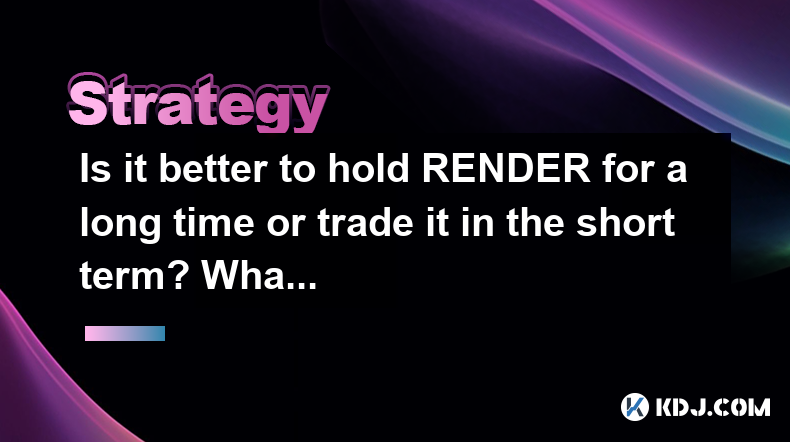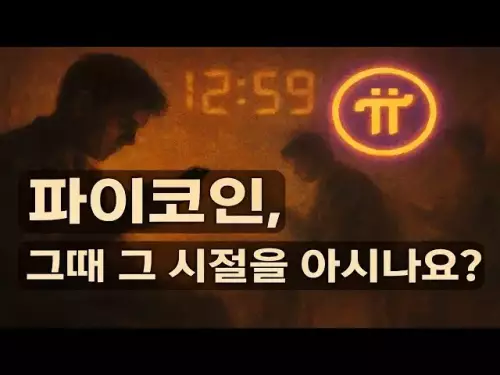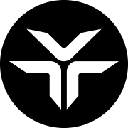-
 bitcoin
bitcoin $112715.707551 USD
-1.71% -
 ethereum
ethereum $4101.475385 USD
-3.01% -
 tether
tether $1.000644 USD
-0.02% -
 bnb
bnb $1207.619465 USD
-6.77% -
 xrp
xrp $2.501451 USD
-3.98% -
 solana
solana $202.947124 USD
-3.32% -
 usd-coin
usd-coin $1.000295 USD
0.04% -
 dogecoin
dogecoin $0.203884 USD
-4.47% -
 tron
tron $0.317154 USD
-1.72% -
 cardano
cardano $0.695009 USD
-4.43% -
 hyperliquid
hyperliquid $38.853961 USD
-8.23% -
 chainlink
chainlink $18.988674 USD
-4.64% -
 ethena-usde
ethena-usde $1.000233 USD
-0.03% -
 stellar
stellar $0.337050 USD
-3.63% -
 bitcoin-cash
bitcoin-cash $536.861728 USD
-1.28%
Is it better to hold RENDER for a long time or trade it in the short term? What are the advantages and disadvantages of the two strategies?
RENDER, tied to the Render Network's GPU rendering services, offers potential growth for long-term holders and volatility for short-term traders. Choose based on your risk tolerance and market knowledge.
May 01, 2025 at 10:07 pm

When considering whether to hold RENDER for the long term or trade it in the short term, it's essential to understand the specific characteristics of the RENDER token and the broader context of the cryptocurrency market. RENDER, a token associated with the Render Network, is designed to facilitate decentralized GPU rendering services. This article will explore the advantages and disadvantages of both long-term holding and short-term trading of RENDER, providing a comprehensive analysis to help you make an informed decision.
Understanding RENDER and Its Market Position
RENDER is the native token of the Render Network, a platform that leverages blockchain technology to create a decentralized network of GPU resources. Users can rent out their GPU power to others, and transactions are facilitated using the RENDER token. The value of RENDER is tied to the demand for GPU rendering services, the growth of the Render Network, and broader market sentiment towards cryptocurrencies.
The Render Network aims to disrupt traditional rendering services by offering a more cost-effective and scalable solution. As the network grows and more users adopt the platform, the demand for RENDER tokens is expected to increase. This potential for growth is a key factor to consider when deciding whether to hold or trade RENDER.
Advantages of Holding RENDER Long-Term
Holding RENDER for the long term can offer several advantages. One of the primary benefits is the potential for significant price appreciation over time. As the Render Network expands and gains more users, the demand for RENDER tokens could increase, driving up its value. Long-term holders can benefit from this growth without the need to actively monitor the market.
Another advantage of long-term holding is the reduced stress and time commitment compared to short-term trading. By holding onto RENDER tokens, investors can avoid the need to constantly monitor market fluctuations and make quick trading decisions. This approach can be particularly appealing to those who prefer a more passive investment strategy.
Additionally, long-term holding aligns well with the ethos of the Render Network. By holding RENDER, investors can show their support for the project and its mission to decentralize GPU rendering services. This can be an important consideration for those who believe in the long-term potential of the Render Network.
Disadvantages of Holding RENDER Long-Term
Despite the potential benefits, there are also several disadvantages to holding RENDER for the long term. One of the main risks is the volatility of the cryptocurrency market. Even if the Render Network continues to grow, the price of RENDER can still experience significant fluctuations due to broader market trends and sentiment.
Another disadvantage is the opportunity cost of holding RENDER. By locking up funds in RENDER tokens, investors may miss out on other investment opportunities that could offer higher returns. This is particularly relevant in the fast-paced world of cryptocurrencies, where new projects and tokens are constantly emerging.
Additionally, the long-term success of the Render Network is not guaranteed. If the project faces technical challenges, regulatory hurdles, or increased competition, the value of RENDER could decline. Long-term holders need to be prepared for the possibility that their investment may not yield the expected returns.
Advantages of Trading RENDER Short-Term
Short-term trading of RENDER can offer several advantages for those who are willing to actively monitor the market and make quick decisions. One of the primary benefits is the potential to capitalize on short-term price movements. Short-term traders can buy RENDER tokens when the price is low and sell them when the price rises, potentially generating profits in a relatively short period.
Another advantage of short-term trading is the ability to take advantage of market volatility. While volatility can be a risk for long-term holders, it can be an opportunity for short-term traders. By carefully analyzing market trends and using technical analysis, traders can identify patterns and make informed trading decisions.
Additionally, short-term trading allows investors to remain flexible and adapt to changing market conditions. If the price of RENDER starts to decline, short-term traders can quickly sell their tokens and move their funds into other investments. This flexibility can help mitigate potential losses and maximize returns.
Disadvantages of Trading RENDER Short-Term
Despite the potential benefits, there are also several disadvantages to trading RENDER in the short term. One of the main risks is the high level of stress and time commitment required. Short-term trading involves constantly monitoring the market, analyzing data, and making quick decisions. This can be mentally exhausting and may not be suitable for everyone.
Another disadvantage is the potential for significant losses. Short-term trading is inherently risky, and even experienced traders can make mistakes. If the price of RENDER moves against a trader's position, they could lose a significant portion of their investment in a short period.
Additionally, short-term trading can be influenced by emotions such as fear and greed, which can lead to poor decision-making. Traders may be tempted to hold onto losing positions in the hope that the price will recover, or they may sell winning positions too early out of fear of a price decline. These emotional responses can undermine the effectiveness of a short-term trading strategy.
Factors to Consider When Choosing a Strategy
When deciding whether to hold RENDER for the long term or trade it in the short term, several factors should be considered. One of the most important factors is your investment goals and risk tolerance. If you are looking for potential long-term growth and are willing to accept the associated risks, holding RENDER may be the better option. On the other hand, if you are seeking to capitalize on short-term price movements and are comfortable with the higher level of risk, short-term trading may be more suitable.
Another factor to consider is your level of knowledge and experience in the cryptocurrency market. Long-term holding requires less active involvement and can be more suitable for those who are new to cryptocurrencies. In contrast, short-term trading requires a deeper understanding of market dynamics and technical analysis, making it more suitable for experienced traders.
Additionally, it's important to consider the current state of the Render Network and the broader cryptocurrency market. If the Render Network is experiencing strong growth and adoption, holding RENDER for the long term may be more appealing. Conversely, if the market is experiencing high volatility and uncertainty, short-term trading may offer more opportunities to capitalize on price movements.
Frequently Asked Questions
Q: How can I stay updated on the developments of the Render Network to make informed decisions about holding or trading RENDER?A: To stay updated on the developments of the Render Network, you can follow their official social media channels, subscribe to their newsletter, and join their community forums. Additionally, keeping an eye on reputable cryptocurrency news websites and joining relevant discussion groups can provide valuable insights into the project's progress and market sentiment.
Q: Are there any specific technical indicators that can help with short-term trading of RENDER?A: Yes, several technical indicators can be useful for short-term trading of RENDER. Some commonly used indicators include Moving Averages, Relative Strength Index (RSI), and Bollinger Bands. These indicators can help traders identify potential entry and exit points based on price trends and momentum.
Q: What are some risk management strategies that can be applied to both long-term holding and short-term trading of RENDER?A: For long-term holding, risk management strategies include diversifying your portfolio, setting stop-loss orders to limit potential losses, and regularly reviewing your investment thesis to ensure it aligns with the current state of the Render Network. For short-term trading, risk management strategies include setting strict entry and exit points, using stop-loss orders, and only risking a small percentage of your total capital on any single trade.
Q: How does the overall market sentiment towards cryptocurrencies impact the decision to hold or trade RENDER?A: The overall market sentiment towards cryptocurrencies can significantly impact the decision to hold or trade RENDER. Positive market sentiment can drive up the price of RENDER, making it more attractive for short-term traders to capitalize on price movements. Conversely, negative market sentiment can lead to price declines, which may be more challenging for short-term traders but could present buying opportunities for long-term holders. It's important to consider broader market trends and sentiment when making decisions about holding or trading RENDER.
Disclaimer:info@kdj.com
The information provided is not trading advice. kdj.com does not assume any responsibility for any investments made based on the information provided in this article. Cryptocurrencies are highly volatile and it is highly recommended that you invest with caution after thorough research!
If you believe that the content used on this website infringes your copyright, please contact us immediately (info@kdj.com) and we will delete it promptly.
- XRP Price Prediction: Weekend Rollercoaster or Rally?
- 2025-10-12 08:45:16
- Bittensor (TAO): Super Bullish Signals Point to Potential 2x Rally
- 2025-10-11 10:25:12
- Silver Price Correction: Navigating the Dip & Identifying Key SEO Keywords
- 2025-10-11 10:25:12
- Decoding Crypto Trends: Bittensor's Bull Run, Cardano's Dip, and LivLive's Presale Buzz in 'Uptober 2025'
- 2025-10-12 08:45:16
- MoonBull: The Crypto Meme Coin Promising 1000x Gains?
- 2025-10-11 10:30:01
- Crypto Payroll Revolution: Stablecoins, Altcoins, and the Future of Salary Payments
- 2025-10-11 10:30:01
Related knowledge

Practical parameter settings for a Bitcoin multi-timeframe moving average system
Sep 18,2025 at 10:54pm
Optimizing Timeframe Combinations for Bitcoin Trading1. Selecting appropriate timeframes is crucial when building a multi-timeframe moving average sys...

How can I filter out false breakouts in Dogecoin high-frequency trading?
Sep 22,2025 at 01:00am
Understanding False Breakouts in Dogecoin Trading1. A false breakout occurs when Dogecoin's price appears to move beyond a defined support or resistan...

Techniques for identifying tops and bottoms in the Bitcoin on-chain NVT model
Sep 20,2025 at 07:54pm
Understanding the NVT Model in Bitcoin Analysis1. The Network Value to Transactions (NVT) ratio is often described as the 'P/E ratio' of the cryptocur...

What does the surge in open interest in Bitcoincoin futures mean?
Sep 20,2025 at 11:18pm
Understanding the Surge in Dogecoin Futures Open Interest1. A surge in open interest within Dogecoin futures indicates a growing number of active cont...

How can I use the Ethereum USDT premium to gauge market sentiment?
Sep 18,2025 at 11:55pm
Understanding the Ethereum USDT Premium1. The Ethereum USDT premium refers to the price difference between USDT (Tether) traded on Ethereum-based plat...

What should I do if Ethereum staking yields decline?
Sep 20,2025 at 06:18am
Understanding the Causes Behind Declining Ethereum Staking Yields1. The Ethereum network transitioned to a proof-of-stake consensus mechanism with the...

Practical parameter settings for a Bitcoin multi-timeframe moving average system
Sep 18,2025 at 10:54pm
Optimizing Timeframe Combinations for Bitcoin Trading1. Selecting appropriate timeframes is crucial when building a multi-timeframe moving average sys...

How can I filter out false breakouts in Dogecoin high-frequency trading?
Sep 22,2025 at 01:00am
Understanding False Breakouts in Dogecoin Trading1. A false breakout occurs when Dogecoin's price appears to move beyond a defined support or resistan...

Techniques for identifying tops and bottoms in the Bitcoin on-chain NVT model
Sep 20,2025 at 07:54pm
Understanding the NVT Model in Bitcoin Analysis1. The Network Value to Transactions (NVT) ratio is often described as the 'P/E ratio' of the cryptocur...

What does the surge in open interest in Bitcoincoin futures mean?
Sep 20,2025 at 11:18pm
Understanding the Surge in Dogecoin Futures Open Interest1. A surge in open interest within Dogecoin futures indicates a growing number of active cont...

How can I use the Ethereum USDT premium to gauge market sentiment?
Sep 18,2025 at 11:55pm
Understanding the Ethereum USDT Premium1. The Ethereum USDT premium refers to the price difference between USDT (Tether) traded on Ethereum-based plat...

What should I do if Ethereum staking yields decline?
Sep 20,2025 at 06:18am
Understanding the Causes Behind Declining Ethereum Staking Yields1. The Ethereum network transitioned to a proof-of-stake consensus mechanism with the...
See all articles


























![Staking ATH: How To Stake $ATH in October 2025 with 523% APY — [Step-By-Step Guide] Staking ATH: How To Stake $ATH in October 2025 with 523% APY — [Step-By-Step Guide]](/uploads/2025/10/15/cryptocurrencies-news/videos/staking-ath-stake-ath-october-apy-stepstep-guide/68eef94d80903_image_500_375.webp)















































